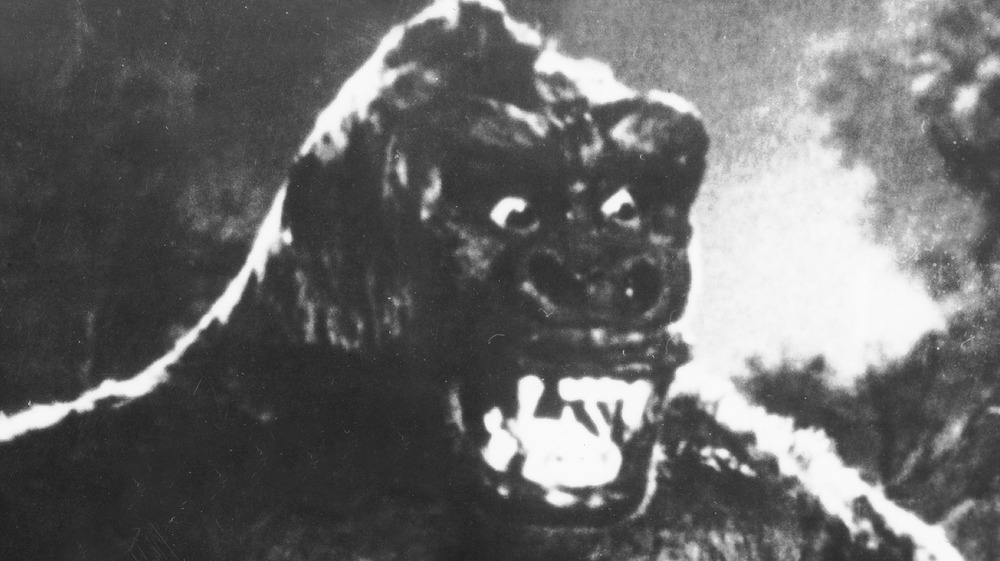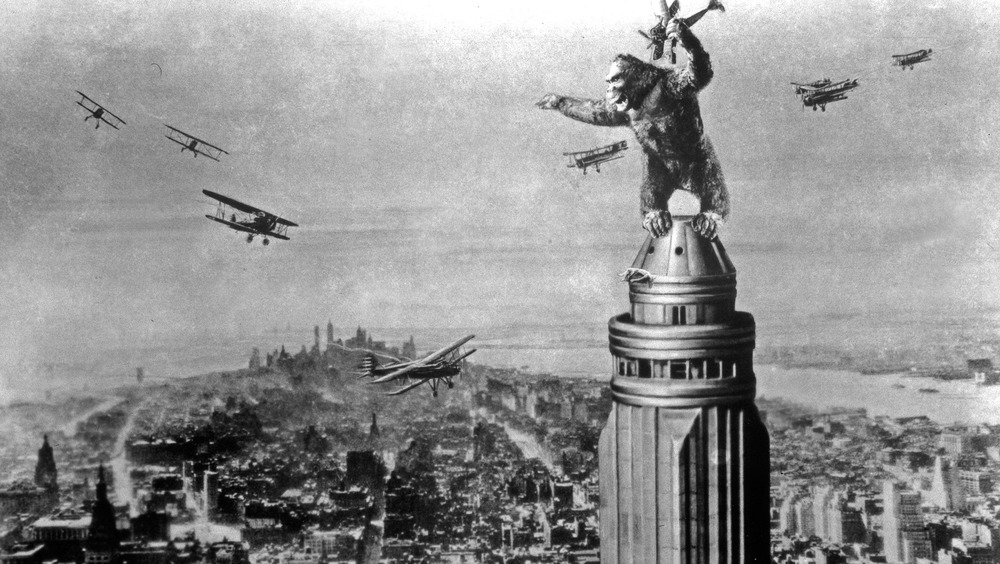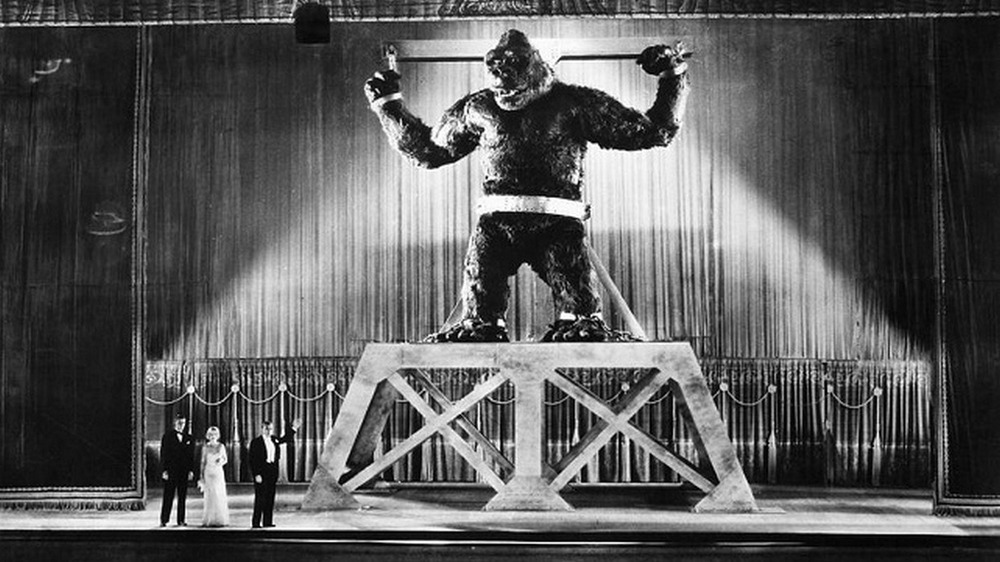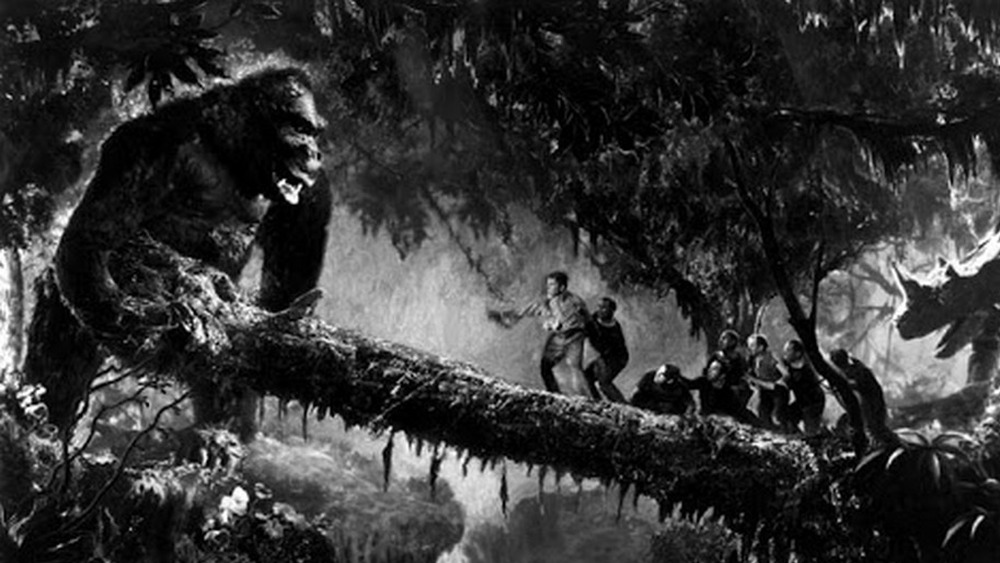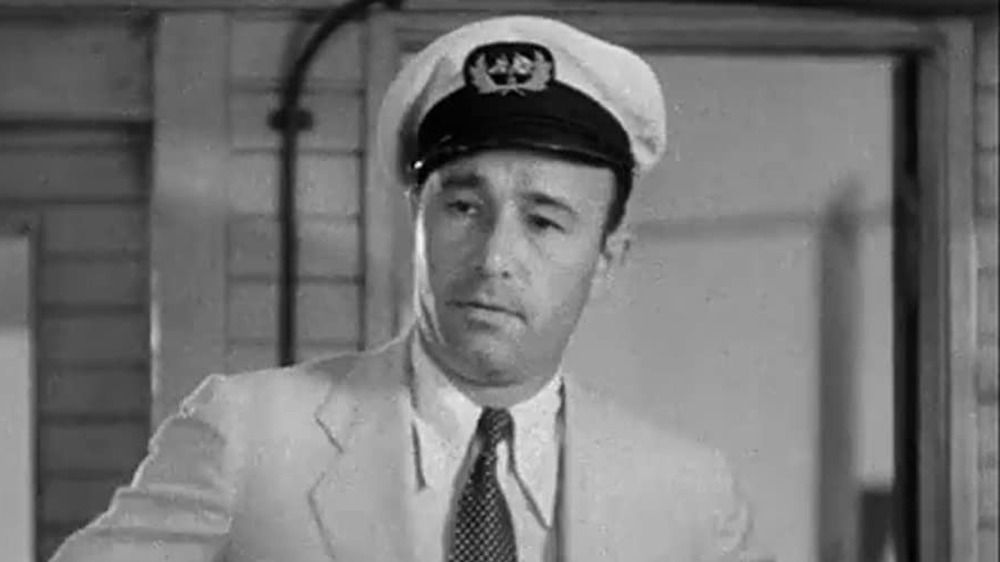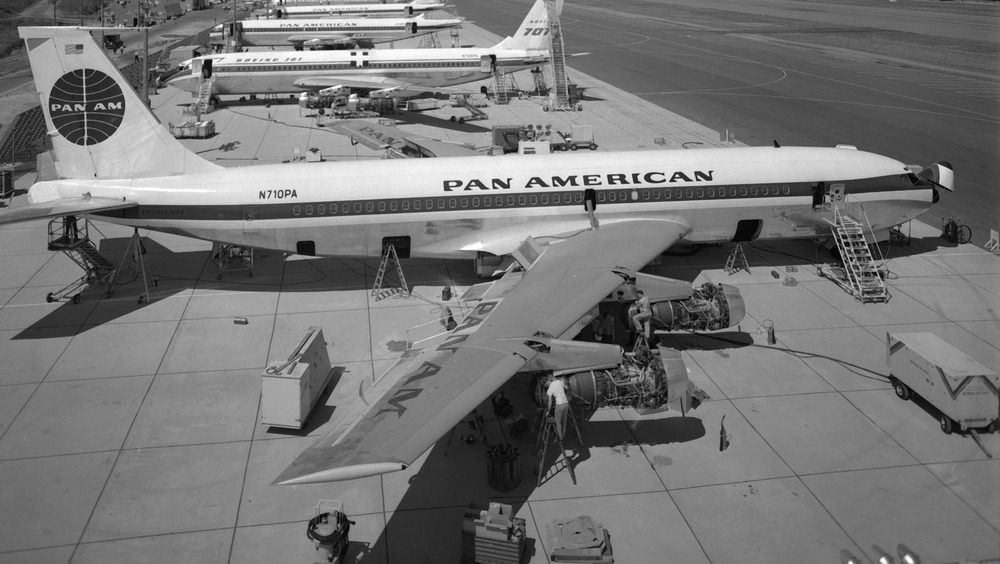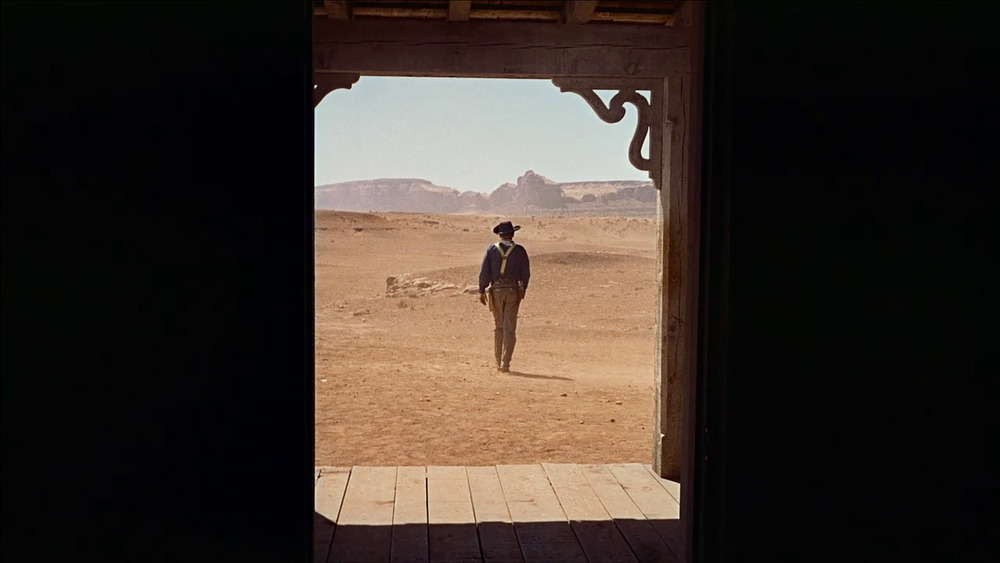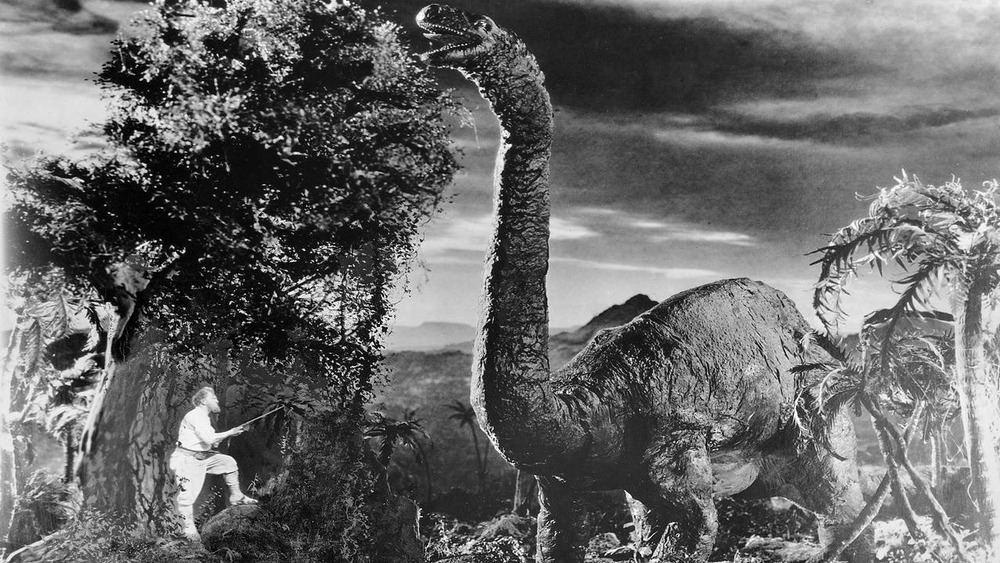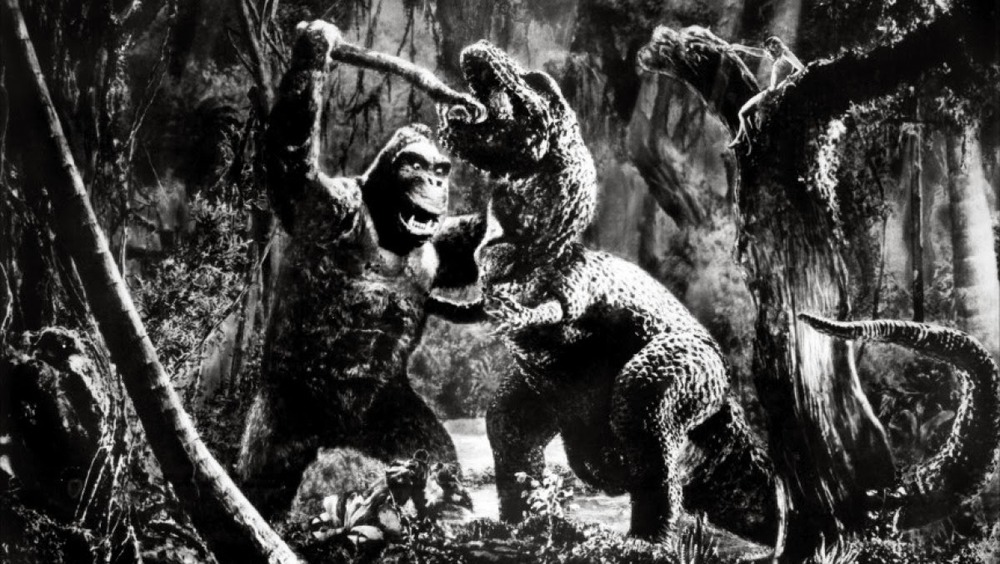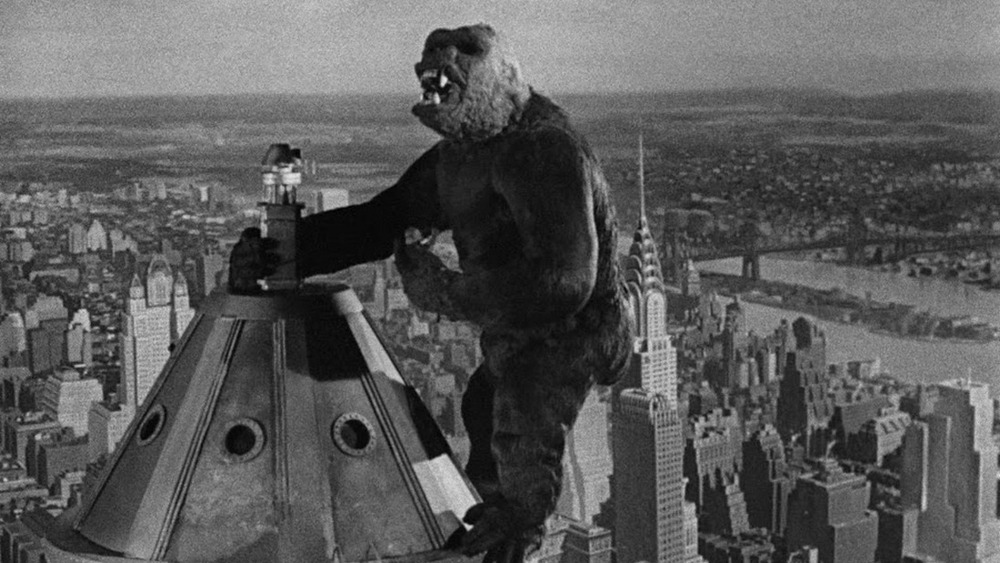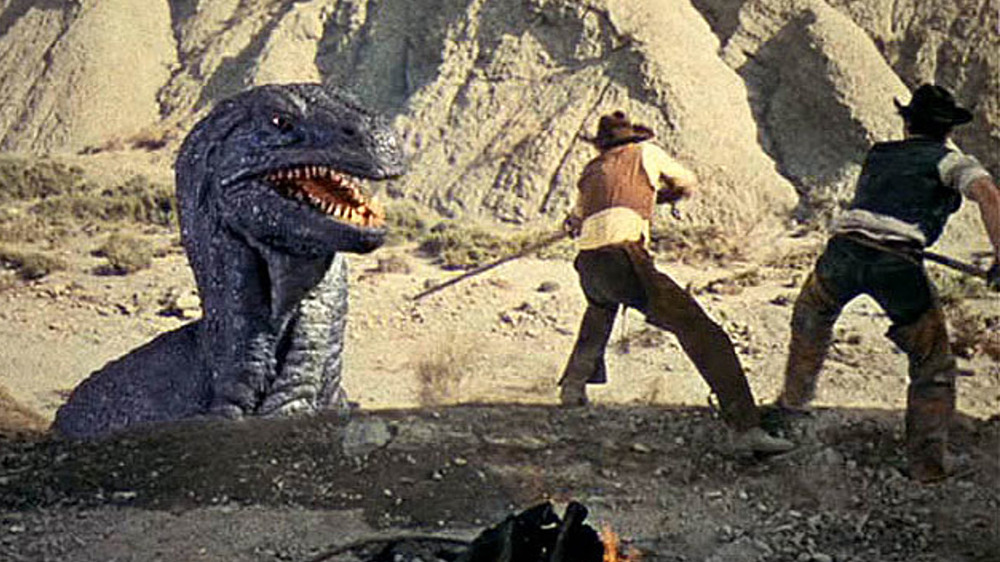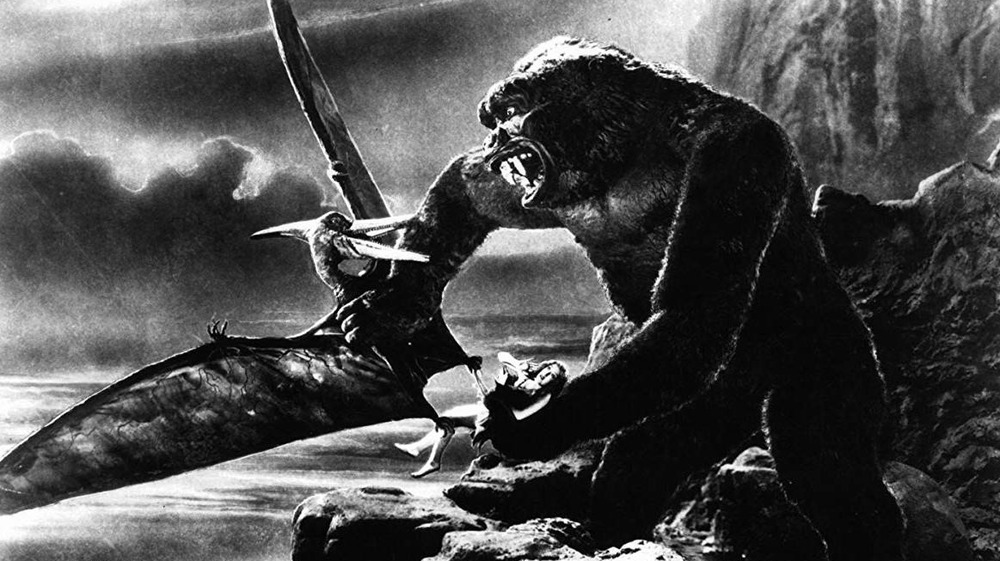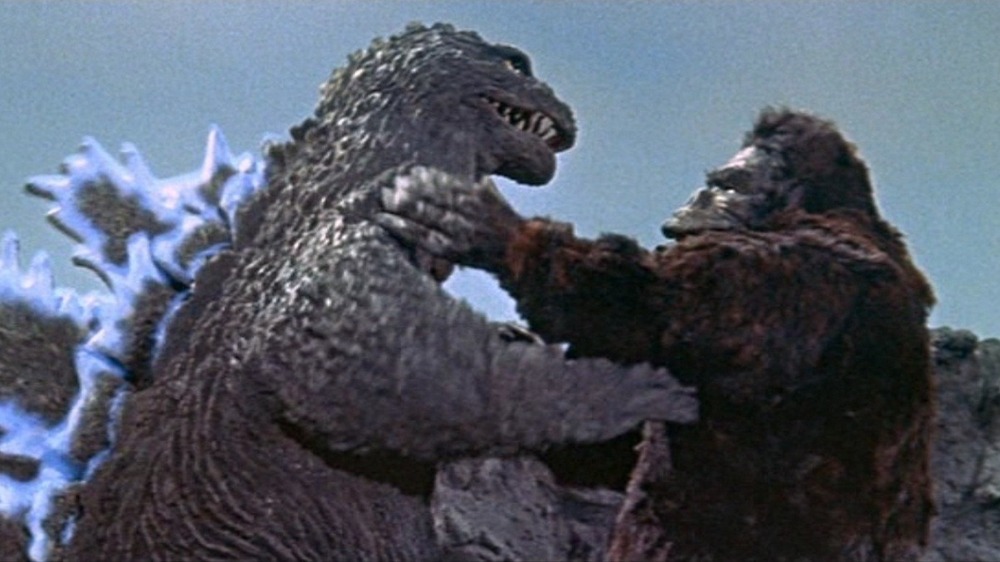The Untold Truth Of King Kong's Creators
King Kong is such a part of pop culture that it seems like he's always been around. Those images — of the giant ape, of him fighting with prehistoric beasts, menacing a woman chained to an ancient altar, chained up himself in a Broadway theater, climbing the Empire State Building as biplanes circle for the kill — hit on such a gut level and have been reproduced and parodied so often that they have some of the power of ancient legends, those stories that have been around who knows how long and were thought up by who knows who.
But King Kong hasn't always been around. Someone had to think him up, and someone else had to bring him to life. And unlike the ancient legends he seems to belong with, King Kong came into existence recently enough that we still have detailed records about just who those people were and what they did. With King Kong returning to the screen in Godzilla vs. Kong, we went through those records, and we found stories there that are almost as thrilling and unbelievable as the one these men told. Here are just a few of them.
Merian C. Cooper flew in both world wars
King Kong came from an idea by Merian C. Cooper, who co-directed the original 1933 movie and put a little of himself into Carl Denham (Robert Armstrong), the leader of the expedition to find Kong. But the already larger-than-life Denham looks almost as dull as a professional accountant next to his creator.
According to Mark Cotta Vaz's biography Living Dangerously, Cooper wanted to be an explorer ever since his uncle gave him Explorations and Adventures in Equatorial Africa by Paul Du Chaillu. When he was a little older, Cooper joined the Naval Academy and got thrown right back out because, in his own words, "I was high-spirited, loved excitement, took chances, and got caught too many times," though he's also said he lost interest because, "I wanted to get into World War I and fly, and realized I couldn't get into flying in the Navy."
He tried to join the war by working his way to London in the merchant marine and jumping ship, but he was caught and sent home. Cooper finally got his chance in the U.S. Army Signal Corps, and his firsthand experience might have inspired the famous bombing scene in Kong. By the time another world war came around, Cooper was well-established in Hollywood, but aviation was still his first love and he re-enlisted, this time as a colonel. He fought in China and India, and even helped plan the Allies' first bombing of Japan in the famous Doolittle Raid.
Cooper escaped from a Soviet prison camp
Cooper served with distinction in and immediately after World War I, but he had his share of defeats as well. After several successful raids in a wooden plane called the De Haviland 4 and nicknamed the "flaming coffin," the craft lived up to its name over France. Cooper stopped the fire by burning out the gas, but he couldn't save the plane, and German soldiers captured him and his co-pilot on landing. They were presumed dead, and Cooper kept his death certificate for years.
After the war, Cooper met his Kong co-director Ernest Shoedshack, who joined him in the Kosciusko Aerial Squadron, a team of American pilots begun by Cooper to help the newly independent Poland in its struggle with the newly formed Soviet Union for control of the Ukraine. Cooper was once again captured over Galicia, and taken to multiple prison camps where the Soviets worked and starved him almost to death. He attempted his first escape five days after his capture, but only made it two days before he was recaptured. Then, after 10 months of imprisonment, Cooper's "American hobo methods" got him back to Warsaw. As soon as he'd recovered from his injuries, Cooper planned to return to liberate the remaining prisoners, but the higher-ups talked him down, afraid of the risk both to international diplomacy and to Cooper personally.
Cooper had a secret son in Poland who'd become famous
On his return to Poland, Cooper began an affair with an older woman named Marjorie Crosby, a British expatriate who'd lived in Russia before fleeing to Poland in the aftermath of the Revolution. Vaz doesn't go into detail on how long they were together, though he does say Cooper was "the great love of [Crosby's] life." Eventually Cooper returned to the States, while Crosby married a Pole named Aleksander Słomczyński. However long the relationship lasted, its aftereffects lasted far longer — in 1922, Crosby gave birth to Cooper's son, Maciej Słomczyński.
While Cooper would help pay for Maciej's upbringing and even offered him a job in the US Army, the American rarely met and never publicly acknowledged his son. Słomczyński managed to make a successful career without his father's help, even following a similar path. Like Cooper, Słomczyński was a war hero, this time in the Polish Resistance against the German invaders, and like Cooper, he escaped a POW camp. Słomczyński also followed his father into the arts as an in-demand translator whose works included James Joyce's Ulysses, Jonathan Swift's Gulliver's Travels, and the complete works of Shakespeare. Under the pen name "Joe Alex," he also became a successful crime author and screenwriter.
Cooper was a real-life Carl Denham
After the war, Cooper finally found his calling as an explorer, living out his childhood dream by transferring it to the world of film. He started out following other explorers, with Shoedshack in tow, to make movies called "travelogues." But that didn't offer enough excitement for Cooper, so he created his own kind of fact-fiction hybrid that he dubbed "natural dramas." They took him around the world, from Iran to Thailand to Indonesia to the Sudan. For many of these movies, Cooper and Shoedshack just went out to film footage of people's daily lives before returning to Hollywood for new scenes that would tie it all up into a narrative.
Grass: A Nation's Battle for Life was mostly a straight documentary about the Iranian Bakhtaris' yearly pilgrimage to find food for their livestock. After a strong opening, it flopped on wide release — believe it or not, Ray Morton's King Kong: The History of a Movie Icon quotes contemporary reviews blaming its failure on the lack of a romantic subplot. Obviously, true documentaries were still beyond audiences of the time.
Cooper and Shoedshack put less fact and more fiction into their follow-up, Chang, creating a plot about a Thai family raising a baby elephant (in Laotian, chang). The climax already shows Cooper and Shoedshack moving Kongward, staging elaborate scenes of wild animal destruction — including battles with leopards and tigers — and a climactic scene where the elephant's mother leads her herd to destroy the village.
Cooper co-founded one of the first commercial airlines
If there's another movie character Cooper resembles, it's Forrest Gump – he has the same talent for finding his way into peripheral roles in American history. Even when he wasn't imagining prehistoric islands and giant apes, Cooper was always dreaming, and he imagined the possibility of commercial air travel as early as 1917. When that dream began approaching reality 10 years later, Cooper was tapped along with several other famous pilots to serve on the board of the new Pan American Airways.
King Kong kept Cooper busy during these early years of the airlines, but whether from the center or the sidelines, he witnessed some of the most important moments in aviation history. Pan Am began with mail routes across the Americas, and by 1936, it was offering passenger flights, some crossing the Pacific to take travelers as far as Hong Kong. By the '50s, Pan Am was the first airline to operate worldwide, and the first to use jet engines. But Pan Am was the victim of its own success — as competitors began using the company's business plan to their own advantage, Pan Am itself went out of business in 1991.
Cooper went on to produce some all-time classics
Cooper wouldn't direct often after King Kong, but he still knew how to parlay his success into continued influence in the film industry. He produced almost 70 movies over the course of his career, and some of them have just as much claim to greatness as Kong. In 1933, the same year King Kong premiered, Cooper co-founded Pioneer Pictures. Two years later, Pioneer released Becky Sharp, Hollywood's first full-length, full-color movie. Cooper continued innovating into the '50s, directing This Is Cinerama, a showcase for a new super-widescreen process that required three cameras to film and three screens to show.
But Cooper's most important movie projects were with legendary Western director John Ford. Together, they formed Argosy Pictures, where Ford directed some of his most acclaimed and beloved films, including The Quiet Man and his Cavalry Trilogy starring John Wayne. Ford and Cooper's last film together was also their most important. The Searchers was another Wayne vehicle, this time complicating both his own image and the rosy view of western expansion that was so widespread at the time. It portrayed Wayne's Indian-hunting anti-hero Ethan Edwards as a dangerous sociopath who goes from wanting to rescue a young girl abducted by Comanches to planning her murder when he learns she's joined the tribe. That moral complexity and the gorgeous Technicolor images of Monument Valley secured The Searchers' GOAT status: Sight and Sound magazine's survey of 846 critics ranked it the seventh-greatest movie ever made.
Willis O'Brien ran away from home to live in the wilderness
King Kong was Cooper's brainchild, but it took Willis O'Brien to bring him to life. Morton's book describes how the animator, nicknamed "Obie," animated Kong's monsters by posing Marcel Delgado's models one frame at a time.
Most animators are the quiet, sedentary type, but not O'Brien. When he was just 14, he ran away from his home in Oakland, California. If Cooper was an international explorer, O'Brien filled the same role at home in a time when much of the North American frontier was still unexplored. The Guardian lists just a few of his colorful careers: fur trapper, cowboy, railroad brakeman, jockey, and wilderness guide.
That's a long way from playing with dolls for a living, but if it weren't for O'Brien's wild younger days, there may never have been a Kong. The animator's fascination with dinosaurs began on the trail, when he took a team of paleontologists to a dig in Crater Lake, Oregon.
That passion continued through his film career, from his first short film for Thomas Edison to his feature adaptation of The Lost World to his unfinished follow-up, Creation. Cooper saw O'Brien at work when he was still trying to sell RKO on Kong and realized he could create his own monsters right in the studio instead of spending thousands of dollars on live gorillas and komodo dragons. O'Brien took his Creation models to Kong, and the iconic images of gorilla-vs.-dinosaur action were born.
O'Brien learned animation as a boxer
After his wilderness years, O'Brien returned to California, but he still wasn't ready to settle down just yet. Instead, he turned to the rough-and-tumble world of boxing. He didn't stay long, but his brief fighting career still had a major impact on O'Brien's future path.
O'Brien slowly began inching toward animation with more artistic work. He took jobs as an architectural draftsman, a sculptor, and then as a sports cartoonist for the San Francisco Daily News. Bored one day, he sculpted a boxer, probably remembering his own time in the ring. A co-worker threw another fighter together, and the two of them pit their little men against each other. Seeing those two inanimate sculptures seem to move set the wheels turning in O'Brien's mind. Could he create the same illusion on film by photographing miniature figures and splicing the images together? That started him on the road to animation. Looking at King Kong, it's easy to see how the former fighter may have drawn on firsthand experience to create the bone-crunching believability of Kong's iconic fight with the Tyrannosaurus rex.
O'Brien's personal life was full of tragedy
As O'Brien's primate creation became a star, his real life deteriorated. The Guardian's profile records the animator's disastrous first marriage to Hazel Ruth Collette, marred by his drinking and womanizing, her struggle with cancer and tuberculosis, and her first suicide attempt, trying to drown herself and their son William by overturning a canoe. In 1930, still trying to finish Creation and just before he discovered Kong, Willis O'Brien left Hazel.
But that wasn't the end of their troubles. In October 1933, seven months after King Kong premiered, O'Brien invited his sons William and Willis Jr. to the studio where he was halfheartedly working on a sequel. Their childlike wonder restored O'Brien's passion for his work. A few days later, both boys were dead. Hazel woke up one night and shot them, then herself. Not only did she survive, the bullet vented the fluid from her lungs and may have even prolonged her life, which ended in a prison hospital.
As for O'Brien, he tried to start over with another woman, also named Hazel, last name Rutherford. But she was also suffering from cancer, and she also committed suicide. A year later, O'Brien met Darlyne Prennett, who he would marry and remain married to for the rest of his life.
O'Brien had big plans for movies that were never made
Once he married Prennett, O'Brien's personal life began to stabilize, but his professional life remained frustrating. He ensured his animation innovations would live on by mentoring an eager young filmmaker named Ray Harryhausen, who would use O'Brien's technique on some of the biggest fantasy films of the next four decades, including Clash of the Titans, Jason and the Argonauts, and The 7th Voyage of Sinbad. O'Brien himself continued working on new projects, including Son of Kong and Mighty Joe Young, but for every movie he completed, there were five or 10 he never got to.
Some of the most exciting might-have-beens in O'Brien's career include The Bubbles, about amoeba-like, tentacled monsters that eat everything they see, with designs that would have been incredible to see in motion; The Giant Pelican, which would have teamed him up with legendary slapstick comedians the Marx Brothers; and new adventures of King Kong in Cinerama.
One of those projects finally made it to the screen — twice — decades later. Scary Monsters magazine reported on an idea O'Brien worked on for many years, combining his loves of dinosaurs, rodeos, and bullfighting. The Nassour Brothers bought one treatment and turned it into The Beast of Hollow Mountain, without O'Brien's involvement. Finally, years after O'Brien's death, Harryhausen found his mentor's script in his garage and decided to bring it to the screen his way, as The Valley of Gwangi in 1969.
O'Brien and Cooper almost reunited for a movie
One of O'Brien's most exciting unmade films would have brought him and Cooper back together for a truly unique fantasy. According to Scary Monsters, it would have been called War Eagles, and it would have featured another lost world of prehistoric monsters, this time focusing on a lost tribe of Viking warriors who fly to battle on giant eagles.
Cooper obviously had himself in mind for the hero: his outline describes the character as "a young, athletic, daring flyer...considered wild as a March hare...He is court-martialed and thrown out of the army." Then the hero flies around the world and finds the prehistoric valley in the Arctic. War Eagles would have built to a spectacular finale where the hero learns America is under attack and leads the eagles to fight the enemy bombers and their ray weapons. This all sounds incredible, and it would have been even more so with plans to release War Eagles as one of the first Technicolor features.
But O'Brien and Cooper's bosses at MGM were skittish about something so close to home in the late '30s, and they turned out to be right. Cooper was called away to fight the real war, and that was the end of War Eagles. Ray Harryhausen tried to revive the project decades later, but for now, a novel adaptation is the best we can get.
O'Brien lost control of his King Kong sequel
Apes and dinosaurs weren't the only monsters that inspired O'Brien. He'd been equally fascinated by Frankenstein from the beginning of his career. Morton writes that ever since the silent era, O'Brien had tried to make a stop-motion version of Mary Shelley's novel, until Universal mounted their iconic adaptation starring Boris Karloff.
But O'Brien returned to Shelley decades later when he wrote a new script for King Kong vs. Frankenstein, where the mad scientist's descendant creates a Kong-sized monster in his secret African lab. Some show business types set out to capture it, just as some of their compatriots are leaving for Skull Island. Kong and Frankenstein share a stage in San Francisco until, of course, they escape and battle each other.
In a sad irony, O'Brien had to ask for the rights to his creation from RKO, now owned by a tire company. The animator made an informal deal with producer Joel Beck. When they lost touch, O'Brien assumed that was the end of the project. In reality, Beck had continued peddling O'Brien's work, and he eventually reached a deal with Toho Studios in Japan. They bought the script and produced their own movie, replacing Frankenstein with their own superstar monster, Godzilla. Beck made a tidy sum, but O'Brien never saw a dime — in fact, he never even learned about King Kong vs. Godzilla until it premiered, with much of his plot intact, shortly before his death.
